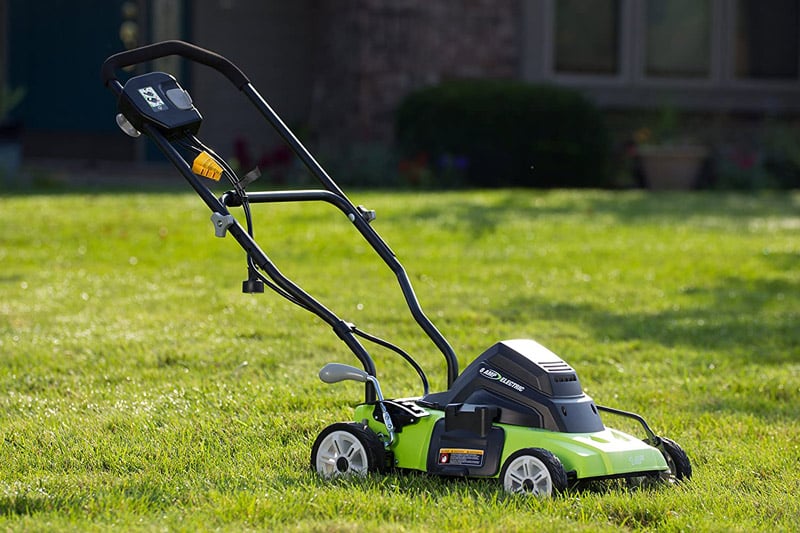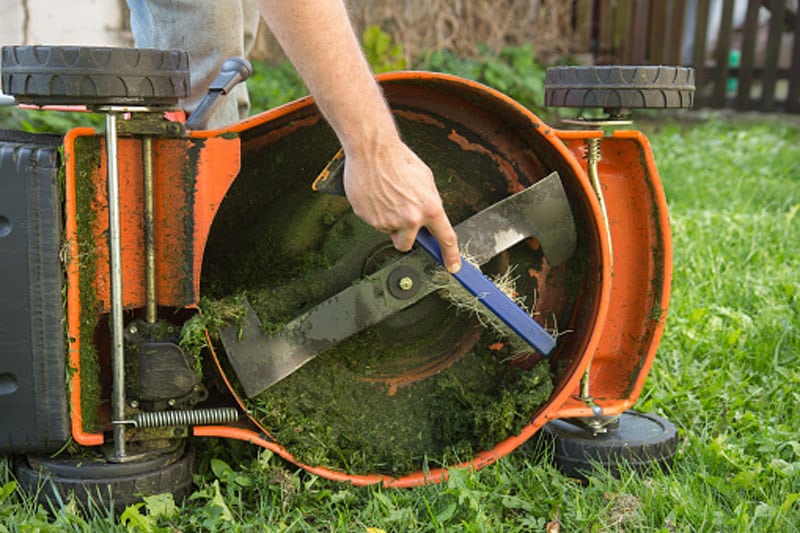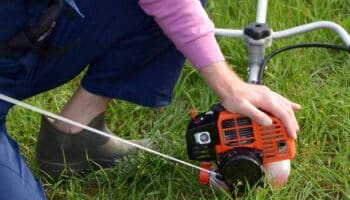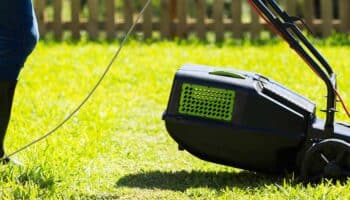Well, wouldn’t you know it? You’ve got the time finally to attack the lawn you’ve been meaning to get to and what happens? Nothing.
Not because of anything you’ve done. No, you’ve planned to get this done.
Yet, regardless of all your planning, your trusty electric mower just won’t start.
Okay, maybe that’s all a bit dramatic. Perhaps you just figured it was as good a time as any to hit the lawn with a well-deserved trim. Or maybe there’s a storm coming through and you wanted to get the mowing done before the grass gets saturated.
Regardless of the circumstances, the main thing is your mower isn’t cooperating, so there’s not going to be any mowing until you figure out what the issue is. That’s the dramatic part.
Just remember, when it comes to an electric mower not starting, whether it’s a corded or battery-powered mower, it will probably be an issue with the power supply (outlet/breaker or battery charger), power transmission (cord or battery), or the mower itself (breakers, connections, motor control switches, etc).
Before you start tearing anything apart in a desperate attempt to get your mower, well, mowing, below are some things to troubleshoot and things to consider that might fix the problem before you have to get a technician or service center involved.
Safety First
First, let’s go ahead and get this out of the way. Always remember safety first when it comes to troubleshooting any kind of equipment that can either cut off fingers or electrocute you or both. That’s a bad day that should be avoided at all costs.
Second, have your manufacturer’s manual (or owner’s manual, whichever you prefer) available. If you don’t have a hard copy, you can probably find it online below.
Once you have that ready, you’re ready to start troubleshooting.
Troubleshooting Process for a Corded or Battery-Powered Mower
Before we get to the specific electric mower you have, the troubleshooting process will follow essentially the same path in this general order:
- Inspect the power transmitter (the cord for a corded mower and the battery for the battery mower).
- Insect the power supply (the outlet and circuit breaker for a corded mower and the battery charger for the battery mower).
- Inspect the power receiving end on the mower.
- Consult your warranty information and contact the service center or a professional if necessary.
A Corded Electric Mower
Before we determine what the power issue with your electric mower may be, first it helps to know the type of electric mower you have. In this case, let’s assume you have a corded mower.
Let’s also assume that, until this moment, you’ve had zero issues with the mower when it comes to starting and stopping it or anything related to sources of power.

Now, let’s troubleshoot.
1. Inspect the Cord
If it is a corded electric mower then the first thing you’re going to want to do is to inspect your cord. As most corded mowers do not come with a manufacturer’s provided cord, you have to provide your own extension cord. It should be a standard 16-gauge grounded cord and free of any cuts or other visible damage. Also, check the prongs on the male end and the female end for damage. Lastly, check the male end on the mower itself.
2. Inspect the Outlet and Breaker
If you’re satisfied the cord is good, try plugging it into another item from the same wall outlet. If there’s no power at the outlet, then you’ve probably identified the issue. It could be a loose wire, a bad outlet, or a tripped breaker. Check one after another until you find the problem.
3. Check the Breaker and Motor Control Switch
If there isn’t a problem at the outlet or breaker and the cord successfully powers something other than the mower, then the issue is probably at the mower itself.
At this point, check the connection at the mower again to make sure it’s tight and holding firm.
From here, go to the breaker on the mower itself. Push RESET and see if the mower has power now. If it does, there was your problem. If it doesn’t then you may have a bad motor control switch. At this point, unless you know how to repair or replace such a switch, you’ll probably need to consult a service center or repair technician.
4. Warranty and Corded MowerTroubleshooting Review
One thing to check that’s not on the mower but applies to it is how old it is and if you still have a warranty on it, whether it’s a manufacturer’s or from the store it was purchased at. If you still have a warranty, don’t do any more work on the mower and place that warranty-issue call to get it fixed.
That pretty much sums it up for a corded electric motor. If it isn’t starting, check the power supply at the plug and main breaker, the power transmission at the cord, and finally the power receiving at the mower itself. Do that in that order. From there, if you can’t identify the problem, time to call for help.
A Battery-Powered Electric Mower
Okay, now if you don’t have a corded electric mower but a battery-operated model, then this section is for you. However, you should still read through the corded mower section because you might pick up on something there that might help someone you know down the road.
Like the corded mower, let’s assume your mower has functioned normally until this moment and, unexpectedly, it’s just not starting.
Well, clearly there’s a power issue of some sort. So, let’s get to troubleshooting.
1. Inspect the Battery
After inspecting the battery, you should be looking for any kind of visual damage or leaks. Also, check the battery light to ensure it does indicate a charge. It might not be true but check all the same.
While inspecting, also make sure the battery is dry. A damp or wet battery can cause a short, lead to overheating, and cause a breakdown. If you believe this happened, you shouldn’t have a solid charge on the battery at all.
Speaking of charges, if everything looks good, and you have a battery tester, this would be an ideal time to test it. That way, if it’s not showing a charge even though the indicator lights up green, then you know the battery is probably bad and needs replacement.
2. Inspect the Battery Charger
If your battery is charged and you’ve tested it and you’re confident it is, then your battery charger should be operating properly. However, if you’ve got no charge on the battery after testing it, check the charger to see if there’s an issue there.
One way to test the charger is, of course, to put another battery on it and see if it charges. However, not everyone has extra lawn mower batteries. Really, the only thing you can do here is to inspect the charger for damage, check the outlet, and inspect the breaker as you would do with a corded mower.
Another thing you can do is use a volt meter. A positive result would indicate that a charger is at least supplying energy but the battery probably can’t hold a charge for long. A negative result would indicate that the charger itself is bad.
3. Consider the Start Switch and Motor
If everything looks good on the battery and charger side, then you’ll next have to consider issues with the Start switch and the motor.
Before tackling them, it doesn’t hurt to check for any loose connection on the mower. Also, check to make sure all vents are clear of grass and any other debris. This should be a routine check before any use but do it again all the same.
If there was debris in the vents, you should still get some kind of indication the mower is getting power from the battery. If you’re not getting any response after all of these troubleshooting steps so far, you’ll probably have to replace the Start switch.
Replacing a Start switch isn’t like swapping out a cord but can be done by yourself or a technician. And it’ll be a lot cheaper than replacing a motor.
If you want to get any replacement part – or see how much one would cost – click to enter your model number in the search bar below. Our partners at AppliancePartsPros stock almost every part with free guides on how to install them.

If you do end up replacing the Start switch and if there still isn’t any power, then it’s definitely time to call a technician or a service center because the motor probably has to be repaired or replaced.
4. Warranty and Battery-Operated Mower Troubleshooting Review
Like with a corded mower, once you reach this point, it’s good to have an idea of your warranty coverage, if you still have any, before calling a service center and paying out of your pocket.
Regardless of whether you have a warranty or not, you did all the troubleshooting you could. There’s nothing wrong with admitting it’s time for outside help when it’s necessary.
Best Practices for Electric Mowers
Yes, sometimes mowers, like any other tool, require repair, whether you do it yourself or get outside assistance. However, there are some things you can do to help keep your mower running at its most effective and hopefully stave off future issues before they become major repair headaches.
1. Keep Your Mower Clean
Yes, it sounds obvious but it never hurts to be reminded. Well-maintained equipment tends to be well-running equipment. Think of it as a type of preventive maintenance. So, every time you clean the blades and vents after use is another way of eliminating a possible problem down the road.

2. Store Your Mower in a Dry Place
Another tip that sounds obvious but one that’s very important when it comes to electric mowers. Remember, water can seriously damage an electric mower, especially a battery-operated one.
3. Store Your Cord and Battery After Use
Don’t leave the cord with the mower where it can get damaged. Store it somewhere it is easy to get to but won’t be affected by things like sharp blades or wheels. You get it.
For batteries, remove them after use and charge them but don’t leave them on the charger all the time. Also, don’t run the battery completely dead all the time. Running a battery to both extremes can diminish its service life quicker than normal.
4. Visually Inspect the Mower Before Use
Again, it sounds obvious but it’s good advice, especially if you haven’t taken a look at the blades in a while.
Conclusion
When you use equipment that runs on electricity or gas, eventually you’ll have an issue that needs some special troubleshooting attention. The good news is, with electric mowers, it doesn’t take much time to figure out what the issue might be and when you’ll need to call for assistance.
Just remember to always be safe, walk through the steps, and be patient. Electricity is a wonderful thing but it isn’t magic. Be safe and remember to call for help if you need it.









